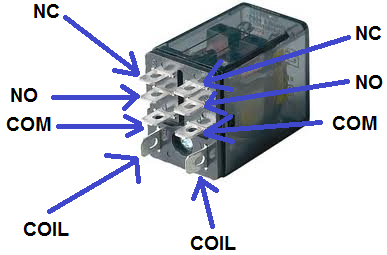Relay Terminals

The terminals that make up a relay are the:
-COM terminal
-NO (Normally Open) Terminal
-NC (Normally Closed) Terminal (for double throw relays)
-COIL Terminals
Pictorial

Terminal Descriptions
-COIL- This the is the COIL terminal. These are the terminals where you apply voltage to in order
to give power to the coils (which then will close the switch). Polarity does not matter. One side gets positive
voltage and the other side gets negative voltage. It doesn't matter which order.
Polarity only matters if a diode is used.
-NO- This is Normally Open switch. This is the terminal where you connect the device that you
want the relay to power, for example, an LED or whatever load, if you want the device to be off when the relay
is not powered and on when the relay is powered.
-NC- This is the Normally Closed Switch. This is the terminal where you connect the device that you want to power
if you want the device to be on normally when the relay isn't powered and off when the relay is powered.
-COM- This is the common terminal of the relay. If the relay is powered and the switch is closed,
COM and NO have continuity. If the relay isn't powered and the switch is open, COM and NC have continuity.
This is the terminal of the relay where you connect the first part of your circuit
to.
